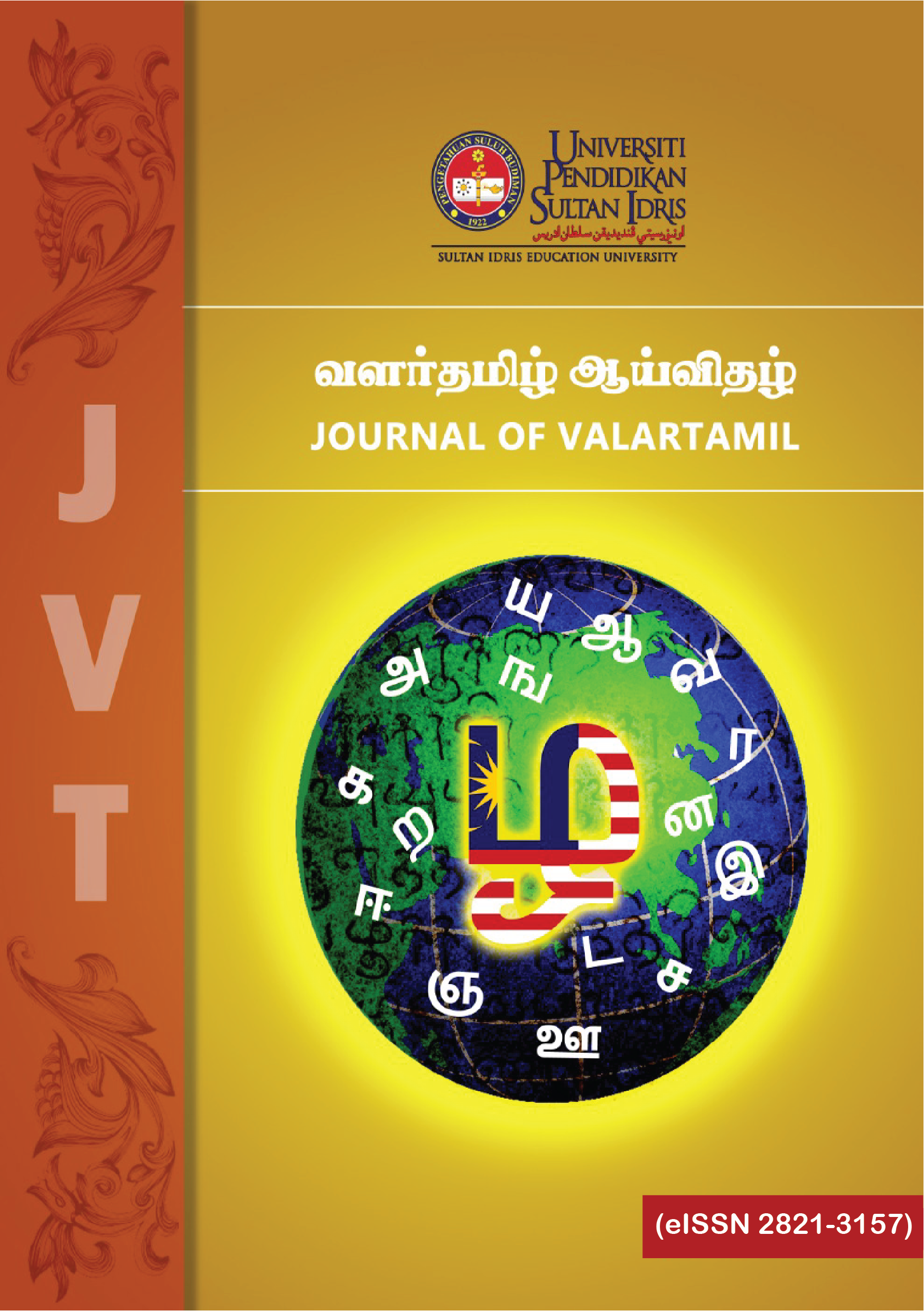சுந்தரர் தேவாரத்தில் காணப்படும் சிவநெறி ஒழுக்கங்கள்
The Discipline of Civaṉeri in Cuntarar Tēvāram
DOI:
https://doi.org/10.37134/jvt.vol2.2.2.2021Keywords:
சுந்தரர் தேவாரம், சிவநெறி, சீவன்முத்தர், சைவசித்தாந்தம், சாதனையியல்Abstract
சுந்தரர் தேவாரத்தில் காணக்கிடக்கும் சிவநெறி ஒழுக்கங்களை அடையாளம் கண்டு கூறுவதே இவ்வாய்வுக் கட்டுரையின் முதன்மை நோக்கமாகும். இவ்வாய்வுக் கட்டுரை பண்புசார் முறையிலும் நூலாய்வு அணுகுமுறையிலும் மேற்கொள்ளப்பட்டுள்ளது. இதன் பகுப்பாய்வு சைவ சித்தாந்தக் கொள்கைகளை அடிப்படையாகக் கொண்டது. சித்தாந்தத்தின் சாதனாவியலில் கூறியவாறு, விடுதலை பெறும் பக்குவத்தில் உள்ள ஆன்மாக்கள் சீவன்முத்தர்களாய் மண்ணுலகில் சிலகாலம் இருப்பர். சுந்தரமூர்த்தி சுவாமிகள் இந்நிலையை அடைந்த சீவன்முத்தராய் இவ்வுலகில் வலம் வந்தவர். ஆகையால், சுந்தரர் பாடிய பாடல்களில் அவர் சுட்டும் சிவநெறி ஒழுக்கங்கள் வெளிப்படுகின்றன. அவற்றைப் பகுத்தும் தொகுத்தும் எட்டுத் துணைத் தலைப்புகளில் இக்கட்டுரை அமைகிறது. சிவநெறி ஒழுக்கங்களில் முதலாவதாகக் குறிக்கப்படுவது ஞானம் பெறுதல் ஆகும். ஞானம் இருவகைகளில் பெறப்படுகின்றது. இறைவன் உள்நின்று உணர்த்துவதாலும் ஆகமநூல்களைக் கற்றறிந்து தெளிவதாலும் ஞானம் பெறலாம். இறைவனே ஞானாசிரியனாக வந்து புகட்டும் ஞானத்தைச் சீவன்முத்தர்கள் கூர்ந்து செவிமடுத்துப்பின் அதனைச் சிந்தித்து ஐயம் தெளிந்து உண்மையை உணர சிவானந்தம் அடைகின்றனர். அடுத்துக் கூறப்படுவது, அனைத்து உயிர்களிடத்தும் செலுத்த வேண்டிய அன்பு பற்றியது. இறைவனே அன்பு வடிவாய் நிற்பதால் அவ்வன்பில் தோயும் உயிராக ஆன்மா நிற்கவேண்டும் என வலியுறுத்தப்படுகிறது. இறைவன்பால் செலுத்தப்படும் அன்பின் செயற்பாடுகள் பத்திமையாகக் கருதப்படுகிறது. சரியை கிரியை யோகம் எனும் மார்க்கங்களின் வழி, கட்டாயக் கடமைகளாகச் சிவச்சின்னங்களை அணிந்து ஐந்தெழுத்து மந்திரத்தை எப்போதும் உச்சரித்துத் திருமுறைகளைப் பாடி மெய்கண்ட சாத்திரங்களைச் செவிமடுத்துச் சிவபூசைகளைச் செய்து சிவனை மனமொழிமெய்களால் தியானிக்க வேண்டும். மேலும், கள்ளும் ஊனும் உண்ணாது காமம், கோபம், பொய்மை ஆகியவற்றிலிருந்து நீங்கியிருத்தல் வேண்டும். மேற்கூறிய வண்ணம் நிற்கும் சீவன்முத்தர்கள் சிவனடியார்களையும் ஞானாசிரியரையும் போற்றி மதிக்க வேண்டும். இறுதியாக, ஆலயவழிபாட்டு நெறி பற்றிக் கட்டுரை கூறுகிறது. ஆலயங்களை இறைவனின் திருமேனியாகவும் அவன் குடிகொள்ளும் இடங்களாகவும் போற்றித் தலயாத்திரையும் பூசனையும் செய்து சீவன்முத்தர்கள் சிவப்பேற்றினைப் பெறுகின்றனர். இவ்வாய்வுக்கட்டுரை, சுந்தரர் தேவாரத்தில் காணப்படும் சிவநெறிகளை அடையாளங் கண்டு கூறும் முதல் ஆய்வுக்கட்டுரையாகும்.The main objective of this research article is to identify and write the disciplines of civaṉeri in Cuntarar Tēvāram. The article is designed in a qualitative approach using the method of text analysis. The analysis is based on the tenets of Saiva Siddhāntam. The Saiva Siddhāntam’s cātaṉaiyiyal says that the liberated souls remain on earth for some time as jīvaṉmuktās. Cuntaramūrti Swamikal is one who had attained liberation to walk around as a jīvaṉmuktā. Hence, his hymns outpour verses of civaṉeri disciplines. These are analysed and synthesised into eight subheadings in this article. The first of the civaṉeri disciplines mentioned, is wisdom. Wisdom is obtained in two ways. It can be obtained by the Lord’s revelation from within and through the understanding of the āgamās. Jīvanmuktās attain the bliss of wisdom by listening and contemplating on the revelations of Lord Civā who comes as a sage to such souls. The next component is love that should be showered on all lives. As the Lord is the embodiment of Love, it is emphasized that the soul that is immersed in the Lord must also exhibit that love. The activities of love towards the Lord become bhakti. Through cariyai, kiriyai and yōgam, the bhaktā should wear the tirunīṟu and rudrāksha, chant the five-letter mantra, sing the Tirumuṟais, listen to the Meykaṇṭa Shāstrās and meditate on Civā. He should abstain from toddy and meat, and refrain from lust, anger and dishonesty. Jīvaṉmuktās should respect and praise the civaservitors and the civaguru. Finally, the article touches on temple discipline. The Civā temples are regarded as the Lord’s manifestation and His dwelling place, and thus the jīvaṉmuktās pilgrimage to these temples to worship and attain bliss. The research claims to be the first such article regarding the discipline of civaṉeri in Cuntarar Tēvāram.
Keywords: Cuntarar Tēvāram, civaṉeri, jīvaṉmuktā, Saiva Siddhāntam, cātaṉaiyiyal
Downloads
References
Arunachalam, P. (1979). Saiva Samayam (Ōr Arimugam). Nagarcoil: Dr.P.Arunachalam, 40-A, Vellalar Colony West Ramavarmapuram.
Ganesalingam, K. (2001). An outline of saivism. London, England: London Meykandar Atheenam.
Hagaliya, S. (2017). Tiruvācakattil pacuk kōṭpāṭu. (Unpublished master's thesis). Universiti Pendidikan Sultan Idris. Tanjung Malim, Malaysia.
Kabirthasan, K. (2004). Caiva ilakkiya vaḷarcciyil Cuntarar centamiḻ. (Unpublished doctoral dissertation). Tamil University. Tanjore, India.
Kandaswamy, S. N. (1997). The concept of God in saiva siddhanta. Thanjavur, India: Saiva Siddhanta Perumanram & Thanjai Tamil Sangam.
Kandaswamy, S. N. (2003). Intiyat tattuvak kaḷañciyam (2nd ed. Vol. III). Chidhamparam: Meyyappan Pathippakam.
Mangkayarkaraci, S. (2010). Cuntararin vāḻviyal kōṭpāṭukaḷ. (Unpublished doctoral dissertation). Annamalai University. Chithamparam, India.
Nallaswami Pillai, J. M. (1948). Sivagnana siddhiyar supakkam of Arulnandhi Sivam. Madras, S.India: Dharmapuram Adhinam.
Nallaswami Pillai, J. M. (1984). Sivagnana botham of Meikanda Deva. Madras: South India Saiva Siddhanta Works Pub. Society.
Natarajan, B. (1991). Tirumantiram: A tamil scriptural classic (B. Natarajan, Trans. N. Mahalingam Ed. 1st ed.). Madras, India: Sri Ramakrishna Math.
Poongkodi, M. (2017). Tirunāvukkaracar tēvārattil pacuk kōṭpāṭu. (Unpublished master's thesis). Universiti Pendidikan Sultan Idris. Tanjung Malim, Malaysia.
Rangaswamy, D. M. A. (1958). The religion and philosophy of tēvāram (E. Sundaramoorthy Ed. 2nd ed.). Madras, India: University of Madras.
Rangaswamy, D. M. A. (1958). The religion and philosophy of tēvāram (E. Sundaramoorthy Ed. 2nd ed.). Madras, India: University of Madras.
Seeta Lechumi, R. K. (2010). A study of saiva concepts depicted in the tiruvicaippa. (Unpublished doctoral dissertation). University Malaya, . Kuala Lumpur, Malaysia.
Sengkalvaraya Pillai, V. S. (1962). Thevaara olinerik katturai (Sundarar). Madras, India: The South India Saiva Siddhanta Works Publishing Society, Tinnelvelly.
Sornapraba, R. (2011). Cuntarar tēvārattil ilakkiya ilakkaṇac ceṟivu. (Unpublished doctoral dissertation). Chennai University. Chennai, India.
Subramanya Pillai, K. (1945). Sivaprakasam of Umapathy Sivam. Chennai, India: Dharmapuram Adhinam.
Thangatturaichi, P. (2018). Cuntarar pāṭalkaḷil pakti neṟi. (Unpublished doctoral dissertation). Manonmaniam Suntharanar University. Tirunelveli, India.
Vacciravēl Mutaliyār, K. (1960). Saivam. Chennai: Government of Tamil Nadu Publications.





